BLOG.
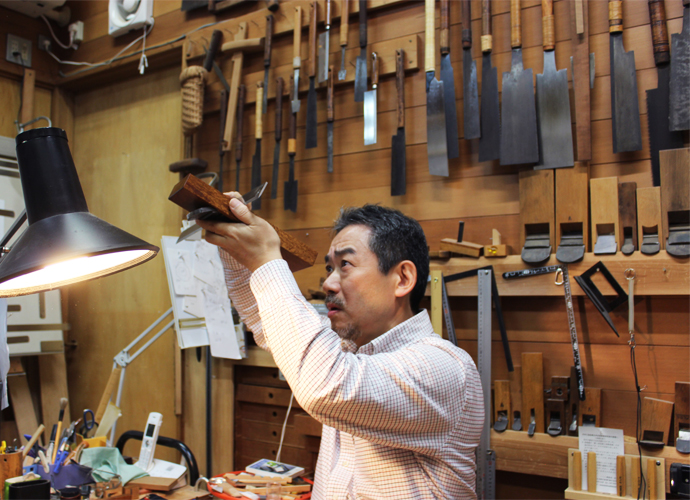
Suda Kenji – Master Craftsman
13th January 2016
Suda Kenji is a woodworking genius, known for his incredibly intricate boxes. The boxes, quite small in size, are a treasure trove of incredibly precise, perfectly executed detail. In 2014, Suda was made a Living National Treasure, by the Minister of Education, Culture, Sports, Science and Technology of Japan, for his woodwork and box making.
I was made aware of Suda’s work by the bamboo master Fujinuma Noboru, and I have been reading Suda’s book, published in 2015, which I’d recommend to anyone interested in Japanese craftsmanship. There’s an excellent English translation alongside the Japanese.
I visited Suda on a wet November day at his home and studio in Gunma Prefecture, two hours north of Tokyo. He is a warm, humble man, who has craftsmanship running through his veins, and comes from a long line of woodworkers.
The first piece he showed me was a long, slim box with an abrupt 20 degree angle in it’s plan a third of the way along it’s 45cm length. It sounds quite an odd shape to describe, but is instantly charming in real life. At the point where the angle changes, the box can open with the help of a hinge on the back side. Inside the box is a set of four drawers, two each side of the hinge.
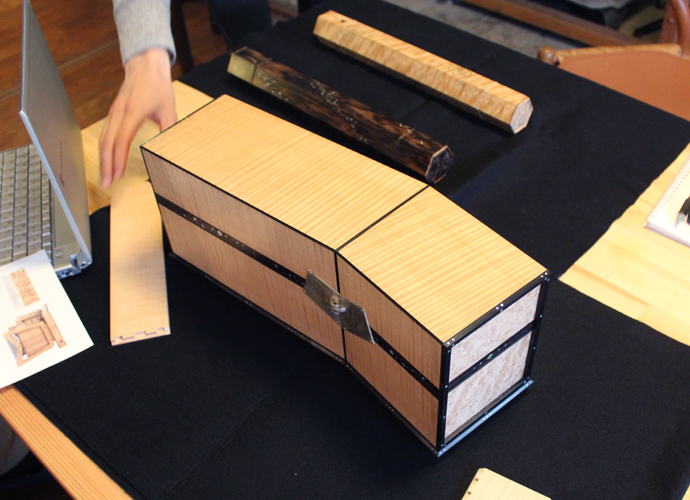
Ripple sycamore box by Suda Kenji
The box is made of the most beautiful ripple sycamore which glints in the light, and is contrasted with a central strip and corner detailing of a black-coloured timber that I can’t pronounce. Inlaid into the black timber, are circles of gold and silver.
As well as being a master woodworking, Suda taught himself to work with precious metals, and makes all the metal work on his pieces. This includes the hinges and the exquisite ‘shrimp’ lock that secures the box when closed.
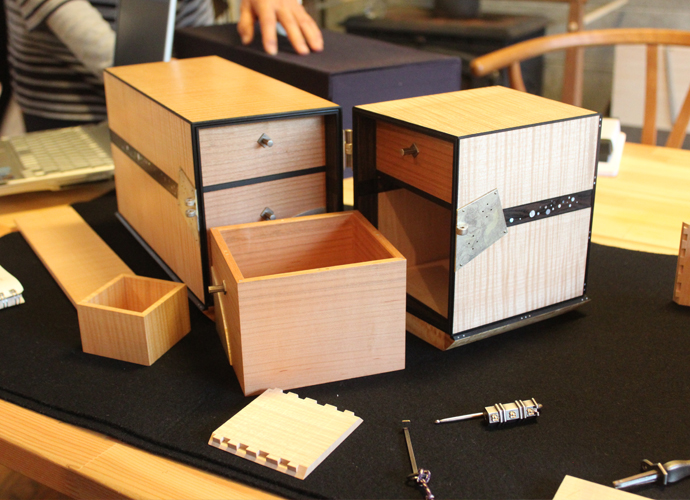
Cherry drawers inside the box are also jointed with hidden dovetails.
The drawers inside the box are made from cherry, and are also inlaid with silver. There is not a single visible joint on the entire piece. In the tradition of Japanese cabinetry, joints are carefully hidden as a demonstration of skill and to allow the beauty of the wood to be paramount in the aesthetics. This was eloquently described to me by another maker as ‘the absence of noise’.
However, this is no veneered block of MDF. This is a solid ripple sycamore box, with perfectly cut hidden mitred dovetails on ever corner. The same joint is used on the corners of the drawers. I studied these joints for some time. They are perfect.
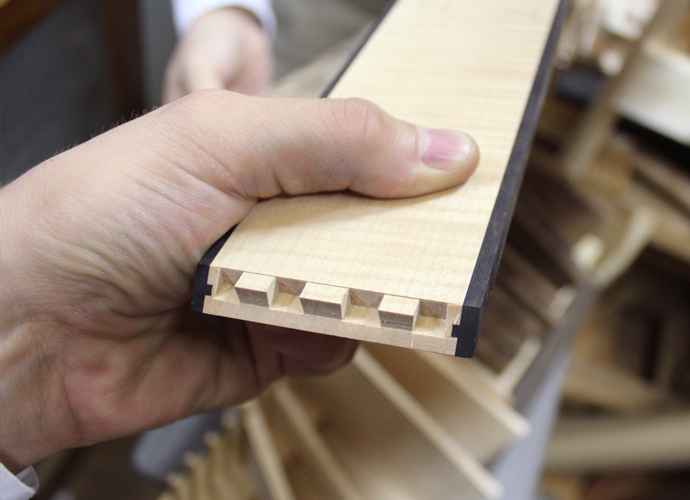
Perfectly executed beds run along this piece of ripple sycamore.
There is another reason, however, that Suda prefers this style of jointing. If they were joined with half-blind dovetails as in the Western style, changes in moisture content could result in the joints protruding slightly on wetter days. This, Suda says, is no good. The fit of the drawers could become too tight or too loose. By hiding the dovetail in the mitre, this can’t happen. I’ll take his word for it because the drawers were the most perfect piston fit I’ve ever experienced.
There is also a very special piece of construction inside the walls of the box. In order to prevent the mouth of the drawer box from swelling and shrinking with changes in humidity, a cross grained piece of sycamore is carefully inserted into a groove in each wall. This construction is hidden by a capping piece made of the black timber with a lambs tongue bead, and which fits perfectly into a matching groove on the opposing side of the box.
It’s worth pointing out that the tolerances here are hundredths of a millimetre. And the details are being machines into panels of sycamore only 7mm thick.
Another detail is that the drawers are set into their boxes with a 0.5mm rebate taken out of the box wall thickness where the drawer pulls out. This is so that the drawers, as they are used, do not scratch the surrounding aprons of timber. It’s a very small detail and incredibly difficult to produce accurately. As with all the other details, I studied it and it is perfectly executed.
Suda is fastidious about moisture content, and conditions the timber he uses constantly. He has a dehumidifying room where he takes air-dried timber down to around 11% moisture content. Each component, when not being worked on, is placed in specially made peg stands and put back in the dehumidifier. A pinless moisture meter is used to measure the results.

The pegged drying rack conditions timber in the dehumidifying room
Another example of his brilliant joint cutter is this sake cup. It’s made of a set of five beautifully jointed pieces of sycamore. Suda assembled them into a sake cup, and poured water in to demonstrate that it was watertight. It was. He drank the water and handed me the cup. The jointing is perfectly hidden within mitres on all sides and faces, including the bottom. And this is with no glue or clamps. gIt’s just perfect. Suda then dismantled it, wiped with a towel and put away. Amazing.
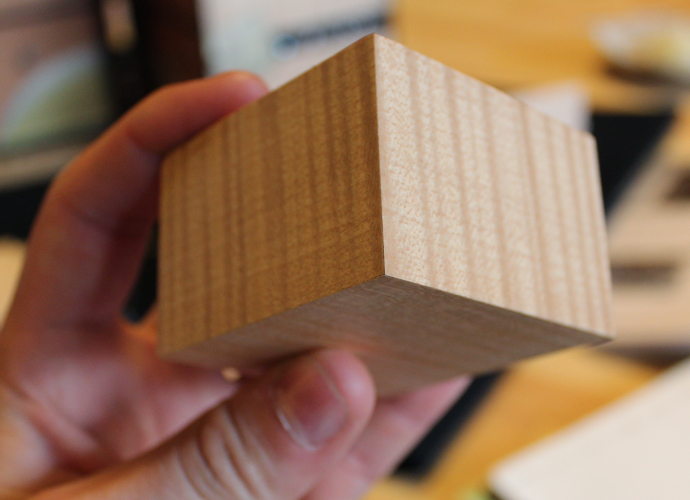
Suda’s watertight sake cup, perfectly jointed with hidden mitred dovetails.
When looking at my work, Suda asked me about my use of exposed jointing. The Japanese tradition of hiding the joints has always been an slightly uncomfortable thing for me. I like to show that the piece is made in solid timber, and I like to articulate the jointing process that has been used to create it. Suda mentions that the name for a dovetail joint in Japanese is ‘ari tsugi’, literally translated as ‘ant joint’ in reference to the widened portion at the rear of an ants body. As a description of the different ways he and I, East and West, use this joint he says ‘there is a great deal of difference in scale between a dove and an ant.
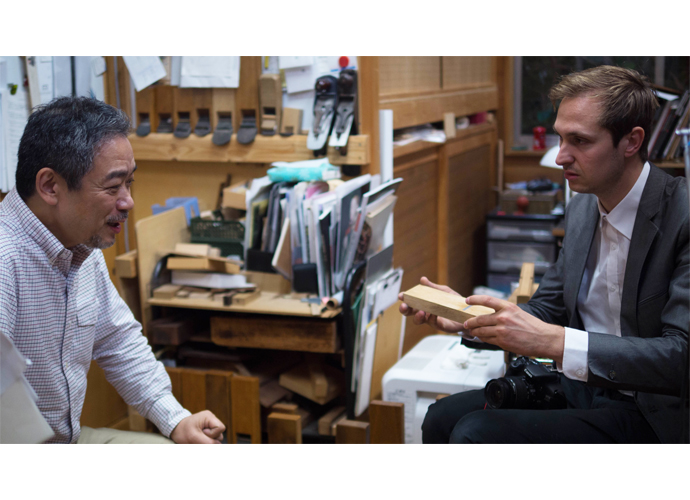
Towards the end of my visit, Suda explained why he uses a special animal liquid glue in his projects which is imported from North America, and tablet type from Japan. It’s because, with the application of heat, the glue can be softened and his pieces can be taken apart. This means they can be repaired easily. He justifies it this way – The timber used in his projects has taken maybe 200 years to grow. He has then worked it for many hours to produce the piece, and he hopes he has given that timber another 200 years of life. Making the repair easier to complete means that his work may last far longer than this.
The legacy of his work is a serious consideration for Suda. Pieces are now held in collections around the world, and one of his boxes has just been added to the British Museum collection. His dedication to quality and precision extends far beyond the bounds of his studio and even beyond his own mortality. He is quite simply the best maker I have ever had the privilege to meet.
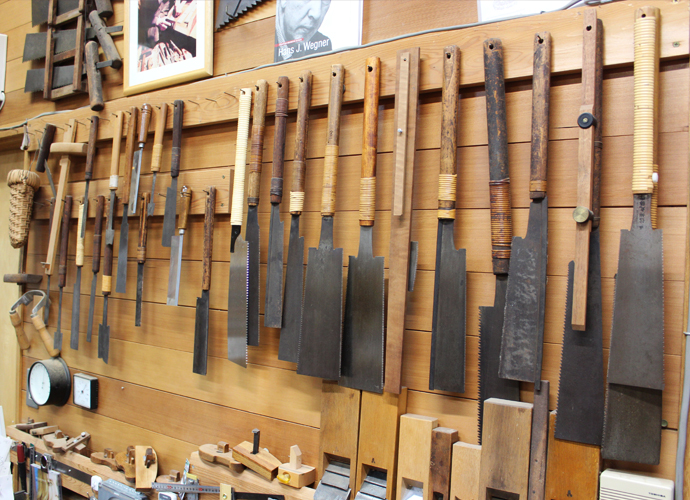
Japanese saws hang on the wall behind Suda’s workbench